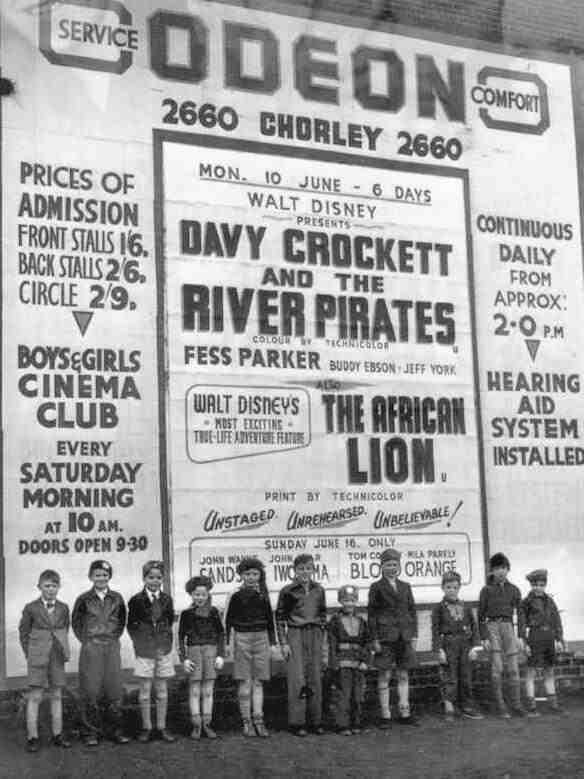
English Film Industry

Figure 1.--The English film industry had trouble competing with Hollywood after World War II. The English boys here in 1957 were particulary taken with "Davy Crockett"--a series produced by the Disney film studio and released on the weekly Disney TV program in America.
|
|
England was active in the early motion picture industry, although French and American figures are better known. English inventors and film makers were active from the very beginning. The growth of the industry was interupted by Wotld war I. And after the War the nascent film indistry was devestated by foreign competition, especially Hollywood. Some work was dine on color film. Legislation requirting theaters to show British made films and the advebt of the talkies revitalized British film making. Many important films were made in the 1930s and some studios even competed with Hillywood in the U.S. market. What you do not see in the 1930s was any hint of criticism of the NAZIs. British film makets like the Government were committed to appeasing Hitler and the NAZIs. We are not sure to what extent this was a marketing decesion to main access to the German market or a policy influenced by the Government. British film makers onve the fight was joined, did play an important role in World War II struggle against the Axis. Many wonderful films were made after the War. ealing studios was especially productive. British film makers, however, continued to have trouble competing with Hollywood.
The 19th Century
Histories of the modern motion picture industry generally focus on Thomas Edison in America who is credited with inventing the motion picture camera (1888) and the Lumière brothers in France who began making films (1895). The history of course is much more complicated and English inventors and cinamatograohers were involved from an early stage. Some historians claim that the first moving pictures developed on celluloid film was shot in Hyde Park, London (1889) by English photigrapher and inventor William Friese Greene. He patented the process (1890). Friese-Grene is a controversial figure. Some claim that he was the real inventor of motion pictures. Other say that his work relied heavily on the pioneering work of others. The debate continues to this date. And his efforts were impaired when he became involved with intractable legal battles. Robert W. Paul and Birt Acres are credited with making the first workable 35 mm camera in Britain. This is important because 35 mm became the film standard for motion pictures. Of course once the cameras were developed, the film making could begin. Paul and Acres made the first British film as opposed to simply shoting film, The film was 'Incident at Clovelly Cottage' (February 1895). Soon after the two split over the patent for the camera. The Luminare Brothers brought their films to London (1896). The public was fascinated and several companies were formed to make films which were in high demand. Mitchell and Kenyon in Blackburn was one of the most important. Americans were involved from an early stage. American Charles Urban expanded the London-based Warwick Trading Company to produce films in Britain (1898). He focused on documentary and news filming. He susewuemtly formed the Charles Urban Trading Company, which worked on early colour films. The earliest British films were simple depictions of everyday events as was the case in other countries.
England in the 20th cetur becanme ione of about five countries (America, England, France, Germany, and the Soviet Union) that launched major movie industries. After World war II, especially by the late-20th century we see more countries developing becomining important film industries. Language was not very impotant with silent filns, but this chaned with the talkies (1930s). The English film industry was assisted by the growing importance of the Enlish language, first because it had access to the American market ad subsequently the large number of English as a second language speakers. English films had a destinct look for many years. You could tell that they were Englisgh even without the accents of the actors. Here English film makers had trouble competing with Hollywood which mastered the action-packed rock-em sock-em films that had great box office appeal. English films tended to be well written, but often lacked action and special affects. There was also problems comopeting wih Grmany's dynamic film industry. Before World War II there were more German than English speakers throughout central abnd Eastern Europe.
The Government had to require movie theaters to show a certain proportion of English-made films. We see both directors and actors migrating to America, this included Elizabeth Taylor and Freddie Bartholmew. It was a one way migration, exceot for a few patriots like Leslie Howard who returned to fight abd die in Workd War II. We see English moving making changing in the late-20th century, adopting Hollywood techniques, butlosing their destinctive English look.
21st Century
HBC

Navigate the Boys' Historical Clothing Web Site:
[Return to the Main English movie page]
[Return to the Main alphabetical movie page]
[Return to the Main European movie industry page]
[Return to the Main country movie page]
[Introduction]
[Activities]
[Biographies]
[Chronology]
[Clothing styles]
[Countries]
[Theatricals]
[Bibliographies]
[Contributions]
[FAQs]
[Glossaries]
[Images]
[Links]
[Registration]
[Tools]
[Boys' Clothing Home]
Created: 2:36 AM 2/21/2007
Last updated: 8:43 PM 7/5/2013



